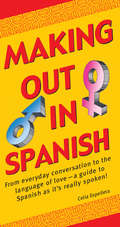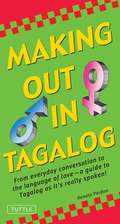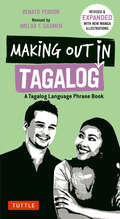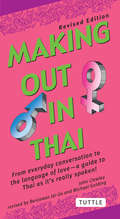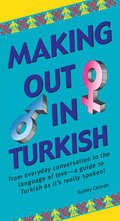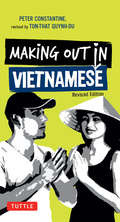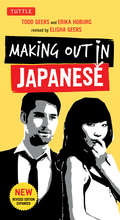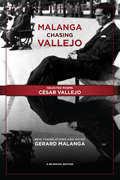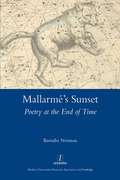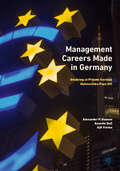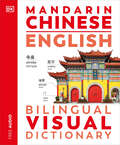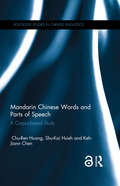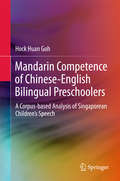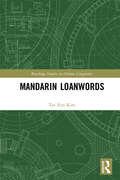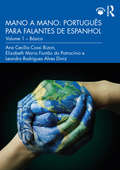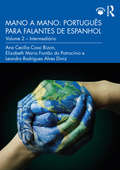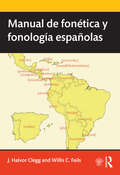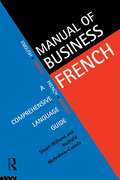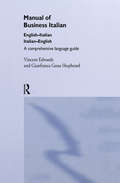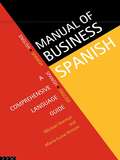- Table View
- List View
Making Out in Spanish: (Spanish Phrasebook)
by Celia EspelletaMaking Out in Spanish is a fun, accessible and thorough Spanish phrase book and guide to the Spanish language as it's really spoken.<P><P>If you are a student, businessman or tourist traveling to Latin America or Spain and would like to have an authentic and meaningful experience, the key is being able to speak like a local. This friendly and easy-to-use Spanish phrasebook makes this possible. Making Out in Spanish has been carefully designed to act as a guide to modern colloquial Spanish for use in everyday informal interactions-giving access to the sort of catchy Spanish expressions that aren't covered in traditional language materials. As well as the Latin script, each expression is now given in phonetics, making pronunciation a breeze. (For example, Buana idea! is also written as BWE-na ee-DE-a!).This Spanish phrasebook includes:Information about Latin American Spanish vs. Spain Spanish as well as regional dialectsA guide to pronouncing Spanish words correctlyExplanations of basic Spanish grammar, such as question forms, male vs. female, formal vs. informal and vowel stressComplete Spanish translations including phonetic scriptUseful and interesting notes on Spanish language and cultureLots of colorful, fun and useful expressions not covered in other phrasebooks
Making Out in Tagalog: (Tagalog Phrasebook)
by Renato PerdonMaking Out in Tagalog is a fun, accessible and thorough Tagalog phase book and guide to the Filipino language as it's really spoken.<P><P>If you are a student, businessman or tourist traveling to the Philippines and would like to have an authentic and meaningful experience, the key is being able to speak like a local. This friendly and easy-to-use Tagalog phrasebook makes this possible. Making Out in Tagalog has been carefully designed to act as a guide to modern colloquial Tagalog for use in everyday informal interactions-giving access to the sort of catchy Filipino expressions that aren't covered in traditional language materials. Each expression is given in Tagalog, so that in the case of difficulties the book can be shown to the person the user is trying to communicate with.This Tagalog phrasebook includes:A guide to pronouncing Tagalog words correctly including vowel combinations and stressing of wordsExplanations of basic Tagalog grammar, such as, word order, pronouns, borrowed words, and polite vs. impolite tensesUseful and interesting notes on Tagalog language and Filipino cultureLots of colorful, fun and useful expressions not covered in other phrasebooks
Making Out in Tagalog: A Tagalog Language Phrase Book
by Renato Perdon Imelda F. GasmenMaking Out in Tagalog is your indispensable guide to contemporary Tagalog language (Filipino) as it's really spoken on the streets of Manila.This best-selling Tagalog phrase book is the perfect introduction to everyday interactions in The Philippines and other Tagalog-speaking countries, and includes colorful slang that'll help rev up your social life. A great way to learn Tagalog, Making Out in Tagalog features a pronunciation guide, and notes on Tagalog language and culture. With Making Out in Tagalog you'll be able to express yourself when: Making new friends Sharing a meal Going out on the town Flirting and getting amorous And much more!Each expression in this book is given in Tagalog and their English translations. It is designed to enhance your experience in using the language (and in a pinch, you can show the Tagalog text to the person you're speaking to). Making Out in Tagalog also includes interesting tips on social norms and cultural practices, eating, social media, hanging out, and other situations. For the savvy traveler, this is a Tagalog phrasebook you won't want to be without!
Making Out in Thai: Revised Edition (Thai Phrasebook)
by Michael Golding Benjawan Jai-Ua John ClewleyMaking Out in Thai is a fun, accessible and thorough Thai phrase book and guide to the Thai language as it's really spoken.Dichan long nai tua khun! Ca phop kan iik muearai?--(I'm crazy about you! When can I see you again?) Answer this correctly in Thai and you may be going on a hot date. <P><P>Incorrectly, and you could be hurting someone's feelings or getting a slap! Thai classes and textbooks tend to spend a lot of time rehearsing for the same fictitious scenarios but chances are while in Thailand you will spend a lot more time trying to make new friends or start new romances--something you may not be prepared for.If you are a student, businessman or tourist traveling to Thailand and would like to have an authentic and meaningful experience, the key is being able to speak like a local. This friendly and easy-to-use Thai phrasebook makes this possible. Making Out in Thai has been revised and redesigned to act as a guide to modern colloquial Thai for use in everyday informal interactions--giving access to the sort of catchy Thai expressions that aren't covered in traditional language materials. As well as the Romanized forms, each expression is given in authentic Thai script (akson thai), so that in the case of difficulties the book can be shown to the person the user is trying to communicate with.This Thai phrasebook includes:A guide to pronouncing Thai words correctlyExplanations of basic Thai grammar, such as, word order and polite vs. impolite formsA guide to male and female usageRomanized forms of words and phrases with tonal markingsComplete translations including Thai script (akson thai)Useful and interesting notes on Thai language and cultureLots of colorful, fun and useful expressions not covered in other phrasebooksTitles in this unique series of bestselling phrase books include: Making Out in Chinese, Making Out in Indonesian, Making Out in Thai, Making Out in Korean, Making Out in Hindi, Making Out in Japanese, Making Out in Vietnamese, Making Out in Burmese, Making Out in Tagalog, Making Out in Hindi, Making Out in Arabic, Making Out in English, More Making Out in Korean, and More Making Out in Japanese.
Making Out in Turkish: Turkish Phrasebook
by Ashley CarmanMaking Out in Turkish is a fun, accessible and thorough Turkish phrase book and guide to the Turkish language as it's really spoken.Sana hayranim! Seni tekrar ne zaman gorecegim?--(I adore you! When can I see you again?) Answer this correctly in Turkish and you may be going on a hot date.<P><P> Incorrectly, and you could be hurting someone's feelings or getting a slap! Turkish classes and textbooks tend to spend a lot of time rehearsing for the same fictitious scenarios but chances are while in Turkey you will spend a lot more time trying to make new friends or start new romances--something you may not be prepared for.If you are a student, businessman or tourist traveling to Turkey and would like to have an authentic and meaningful experience, the key is being able to speak like a local. This friendly and easy-to-use Turkish phrasebook makes this possible. Making Out in Turkish has been carefully designed to act as a guide to modern colloquial Turkish for use in everyday informal interactions--giving access to the sort of catchy Turkish expressions that aren't covered in traditional language materials. Each expression is given in authentic Turkish (turkce) so that in the case of difficulties the book can be shown to the person the user is trying to communicate with. In addition, phonetic spellings are also included making speaking Turkish a breeze. For example "Okay"--Tamam, is also given as ta-MAHM. This Turkish phrasebook includes:A guide to pronouncing Turkish words correctlyExplanations of basic Turkish grammar, such as, double letters, vowel harmony, agglutination, questions, and negationComplete Turkish translations including phonetic spellingsUseful and interesting notes on Turkish language and cultureLots of colorful, fun and useful expressions not covered in other phrasebooksTitles in this unique series of bestselling phrase books include: Making Out in Chinese, Making Out in Indonesian, Making Out in Thai, Making Out in Korean, Making Out in Hindi, Making Out in Japanese, Making Out in Vietnamese, Making Out in Burmese, Making Out in Tagalog, Making Out in Hindi, Making Out in Arabic, Making Out in English, More Making Out in Korean, and More Making Out in Japanese.
Making Out in Vietnamese
by Peter Constantine Ton-That Quynh-DueMaking Out in Vietnamese is a fun, accessible and thorough Vietnamese phrase book and guide to the Vietnamese language as it's really spoken.Anh dien cuong vi em! Chung ta gap lai sau duoc khong? (I m crazy about you! Can we meet again?) Answer this correctly in Vietnamese and you may be going on a hot date. Incorrectly, and you could be hurting someone s feelings or getting a slap! Vietnamese classes and textbooks tend to spend a lot of time rehearsing for the same fictitious scenarios but chances are while in Vietnam you will spend a lot more time trying to make new friends or start new romances something you may not be prepared for.If you are a student, businessman or tourist traveling to Vietnam and would like to have an authentic and meaningful experience, the key is being able to speak like a local. This friendly and easy-to-use Vietnamese phrasebook makes this possible. Making Out in Vietnamese has been carefully designed to act as a guide to modern colloquial Vietnamese for use in everyday informal interactions giving access to the sort of catchy Vietnamese expressions that aren't covered in traditional language materials. Each expression is written in Vietnamese next to the English, so that in the case of difficulties the book can be shown to the person the user is trying to communicate with.This Vietnamese phrasebook includes:A guide to pronouncing Vietnamese words correctlyExplanations of basic Vietnamese grammar, such as, personal pronouns and tonesA guide to male and female usageAuthentic Vietnamese script (Chu Nom) as well as simplified phonetic spellings for all phrasesUseful and interesting notes on Vietnamese language and cultureLots of colorful, fun and useful expressions not covered in other phrasebooksTitles in this unique series of bestselling phrase books include: Making Out in Chinese, Making Out in Indonesian, Making Out in Thai, Making Out in Korean, Making Out in Hindi, Making Out in Japanese, Making Out in Vietnamese, Making Out in Burmese, Making Out in Tagalog, Making Out in Hindi, Making Out in Arabic, Making Out in English, More Making Out in Korean, and More Making Out in Japanese.
Making Out in Vietnamese
by Peter Constantine Ton-That Quynh-DueMaking Out in Vietnamese is a fun, accessible and thorough Vietnamese phrase book and guide to the Vietnamese language as it's really spoken.Anh dien cuong vi em! Chung ta gap lai sau duoc khong?--(I'm crazy about you! Can we meet again?) Answer this correctly in Vietnamese and you may be going on a hot date. Incorrectly, and you could be hurting someone's feelings or getting a slap! Vietnamese classes and textbooks tend to spend a lot of time rehearsing for the same fictitious scenarios but chances are while in Vietnam you will spend a lot more time trying to make new friends or start new romances--something you may not be prepared for.If you are a student, businessman or tourist traveling to Vietnam and would like to have an authentic and meaningful experience, the key is being able to speak like a local. This friendly and easy-to-use Vietnamese phrasebook makes this possible. Making Out in Vietnamese has been carefully designed to act as a guide to modern colloquial Vietnamese for use in everyday informal interactions--giving access to the sort of catchy Vietnamese expressions that aren't covered in traditional language materials. Each expression is written in Vietnamese next to the English, so that in the case of difficulties the book can be shown to the person the user is trying to communicate with.This Vietnamese phrasebook includes:A guide to pronouncing Vietnamese words correctlyExplanations of basic Vietnamese grammar, such as, personal pronouns and tonesA guide to male and female usageAuthentic Vietnamese script (Chu Nom) as well as simplified phonetic spellings for all phrasesUseful and interesting notes on Vietnamese language and cultureLots of colorful, fun and useful expressions not covered in other phrasebooksTitles in this unique series of bestselling phrase books include: Making Out in Chinese, Making Out in Indonesian, Making Out in Thai, Making Out in Korean, Making Out in Hindi, Making Out in Japanese, Making Out in Vietnamese, Making Out in Burmese, Making Out in Tagalog, Making Out in Hindi, Making Out in Arabic, Making Out in English, More Making Out in Korean, and More Making Out in Japanese.
Making Sense of Japanese: What the Textbooks Don't Tell You (Power Japanese Ser.)
by Jay RubinMaking Sense of Japanese is the fruit of one foolhardy American's thirty-year struggle to learn and teach the Language of the Infinite. Previously known as Gone Fishin', this book has brought Jay Rubin more feedback than any of his literary translations or scholarly tomes, "even if," he says, "you discount the hate mail from spin-casters and the stray gill-netter."To convey his conviction that "the Japanese language is not vague," Rubin has dared to explain how some of the most challenging Japanese grammatical forms work in terms of everyday English. Reached recently at a recuperative center in the hills north of Kyoto, Rubin declared, "I'm still pretty sure that Japanese is not vague. Or at least, it's not as vague as it used to be. Probably."The notorious "subjectless sentence" of Japanese comes under close scrutiny in Part One. A sentence can't be a sentence without a subject, so even in cases where the subject seems to be lost or hiding, the author provides the tools to help you find it. Some attention is paid as well to the rest of the sentence, known technically to grammarians as "the rest of the sentence."Part Two tackles a number of expressions that have baffled students of Japanese over the decades, and concludes with Rubin's patented technique of analyzing upside-down Japanese sentences right-side up, which, he claims, is "far more restful" than the traditional way, inside-out."The scholar," according to the great Japanese novelist Soseki Natsume, is "one who specializes in making the comprehensible incomprehensible." Despite his best scholarly efforts, Rubin seems to have done just the opposite.Previously published in the Power Japanese series under the same title and originally as Gone Fishin' in the same series.
Making out in Japanese
by Todd Geers Erika HoburgMaking Out in Japanese is a fun, accessible and thorough Japanese phrase book and guide to the Japanese language as it's really spoken. Sugoku suki! Mata aeru?;(I'm crazy about you! Shall we meet again?) Answer this correctly in Japanese and you may be going on a hot date. Incorrectly, and you could be hurting someone's feelings or getting a slap! Japanese classes and textbooks tend to spend a lot of time rehearsing for the same fictitious scenarios but chances are while in Japan you will spend a lot more time trying to make new friends or start new romances; something you may not be prepared for. If you are a student, businessman or tourist traveling to Japan and would like to have an authentic and meaningful experience, the key is being able to speak like a local. This friendly and easy-to-use Japanese phrasebook makes this possible. Making Out in Japanese has been updated and expanded to be even more helpful as a guide to modern colloquial Japanese for use in everyday informal interactions; giving access to the sort of catchy Japanese expressions that aren't covered in traditional language materials. As well as the Romanized forms (romanji), each expression is now given in authentic Japanese script (kanji and kana with furigana pronunciation clues), so that in the case of difficulties the book can be shown to the person the user is trying to communicate with. This Japanese phrasebook includes: A guide to pronouncing Japanese words correctly. Explanations of basic Japanese grammar, such as, intonation, word stress, and particles. A guide to male and female usage. Romanised forms of words and phrases (romanji). Complete Japanese translations including Japanese characters (kanji) and the Japanese alphabet (kana). Useful and interesting notes on Japanese language and culture. Lots of colourful, fun and useful expressions not covered in other phrasebooks. Titles in this unique series of bestselling phrase books include: Making Out in Chinese, Making Out in Indonesian, Making Out in Thai, Making Out in Korean, Making Out in Hindi, Making Out in Japanese, Making Out in Vietnamese, Making Out in Burmese, Making Out in Tagalog, Making Out in Hindi, Making Out in Arabic, Making Out in English, More Making Out in Korean, and More Making Out in Japanese.
Making out in Japanese
by Todd Geers Erika HoburgThe books in the Making Out series are fun and accessible guides to languages as they're spoken on the street. These classic phrase books have been updated and expanded for use in informal situations such as bars, parties, or anywhere else one needs to know slang to survive! The books also now feature phrases written in their native script as well as in English, so the book can be shown to the person you are trying to communicate with. With transcriptions revised for easier pronunciation, these helpful books will have you making out in no time! Making Out in Japanese is a fun, accessible and thorough guide to Japanese as it's really spoken. It has been updated and expanded to be even more helpful as a guide to modern colloquial Japanese for use in everyday informal interactions-giving access to the sort of catchy expressions that aren't covered in traditional language materials. As well as the romanized forms, each expression is now given in authentic Japanese script (kanji kana with furigana pronunciation clues), so that in the case of difficulties the book can be shown to the person the user is trying to communicate with.
Malanga Chasing Vallejo: César Vallejo
by César Vallejo Gerard MalangaIn the forceful, staggering poetry of César Vallejo, poet and photographer Gerard Malanga discovered a kindred spirit. Driven by a deep sense of spiritual kinship and with the encouragement of Vallejo's widow, Malanga's translations reveal a profound perspective on Vallejo's work that brings into focus the brutal desperation behind his genius. Malanga Chasing Vallejo gathers 82 of Vallejo's poems in a bilingual edition that is marked by the spiritual connection between poet and translator. A work of the heart, these poems are presented from the position of a fellow member of the underclass, providing a street-level entry point for readers who can relate to the hunger feeding every verse and the ache of loneliness that no amount of modern technology can obscure. In addition to the poems, Malanga's heartfelt introduction describes the process of his 45-year commitment to this project. The book also includes a poem about Vallejo by Malanga, rare photos of Vallejo, and transcriptions of several never-before-published letters to Malanga from Vallejo's widow, Georgette de Vallejo, which guided his translation efforts.
Mallarme's Sunset: Poetry at the End of Time
by Barnaby NormanThe writings of the great Symbolist poet Stephane Mallarme (1842-1898) were to become uniquely influential in twentieth century literary criticism. For critics and philosophers such as Maurice Blanchot and Jacques Derrida, Mallarme's name came to represent a rupture in literary history, and an opening of literature onto a radically new kind of writing. Through close readings of key works, Norman retraces Mallarme's trajectory as a poet, showing in particular how he positioned his work in relation to Hegel's Aesthetics. Analysing the motif of the sunset Norman argues that Mallarme situated his work at the conclusion of the history of art, in Hegelian terms, and it is this that made him so interesting for Blanchot and Derrida. Their readings, born of their wish to subvert Hegel's totalizing impulse, give rise to an entirely new view of works now almost universally seen as masterpieces.
Management Careers Made in Germany: Studying at Private German Universities Pays Off
by Ajit Varma Alexander P. Hansen Annette DollThis book reveals how to provide the leaders of tomorrow with the right education for a management career Made in Germany. It explains how private universities in Germany are helping to maintain the country’s respected educational standards, while also enriching them with exemplary services for international students.The book is intended as a practical guide, addressing any concerns students may have when considering studying at a private German university: admissions, visa, teaching quality and formats, tuition, degrees, subjects, housing, food, security, industry connections, and international job placement and leadership. It provides concrete strategies on how students can unlock their personal earning potential and how to find a top job at a national or multinational company. The authors demonstrate that a German university degree will generate rapid return on investment. Real-life success stories show how a degree from a private German university can pave the way for international professional success.
Mandarin Chinese - English Bilingual Visual Dictionary (DK Bilingual Visual Dictionaries)
by DKWith more than 6,750 fully illustrated words and phrases in Mandarin Chinese and English, along with a free bilingual audio app, DK's Mandarin Chinese-English Bilingual Visual Dictionary is your essential companion to life in any Mandarin Chinese–speaking country.You will learn all the words and phrases you need to buy food and clothes, talk about work and education, visit the doctor, go to the bank, use public transportation, and much more. Perfect for tourists, business travelers, and students, the dictionary is incredibly easy to follow, with thematically organized vocabulary so you can find closely related words on a particular topic. Words and phrases are illustrated with full-color photographs and artwork, helping to fix new vocabulary in your mind. A comprehensive, two-way index provides an instant reference point for new Mandarin Chinese vocabulary.The supporting audio app enables you to hear all the words and phrases spoken out loud in Mandarin Chinese. The app is easy to use and helps you learn, remember, and pronounce important vocabulary. The dictionary gives a pronunciation guide for every Mandarin Chinese word, and you can use this alongside the app to perfect your pronunciation.
Mandarin Chinese Words and Parts of Speech: A Corpus-based Study (Routledge Studies in Chinese Linguistics)
by Chu-Ren Huang Shu-Kai Hsieh Keh-Jiann ChenThis monograph is a translation of two seminal works on corpus-based studies of Mandarin Chinese words and parts of speech. The original books were published as two pioneering technical reports by Chinese Knowledge and Information Processing group (CKIP) at Academia Sinica in 1993 and 1996, respectively. Since then, the standard and PoS tagset proposed in the CKIP report have become the de facto standard in Chinese corpora and computational linguistics, in particular in the context of traditional Chinese texts. This new translation represents and develops the principles and theories originating from these pioneering works. The results can be applied to numerous fields; Chinese syntax and semantics, lexicography, machine translation and other language engineering bound applications. Suitable for graduate and scholars in the fields of linguistics and Chinese, Mandarin Chinese Words and Parts of Speech provides a comprehensive survey of the issues around wordhood and PoS.
Mandarin Competence of Chinese-English Bilingual Preschoolers
by Hock Huan GohThis book provides readers with a detailed sketch of the Mandarin competence of Chinese children in Singapore from different home language backgrounds. Their Mandarin competence is defined in terms of lexical diversity, syntactic complexity and code-switching tendency. The findings presented show that there are statistical differences in lexical diversity and syntactic complexity among the compared groups of children, and these differences in linguistic competence were found to be positively correlated to increased Mandarin exposure at home. They also demonstrate that there are statistical differences in code-switching tendency among the groups of children compared, which were found to be negatively correlated to increased exposure to Mandarin at home. A general relationship between home language exposure and Mandarin competence was established, although this relationship was found to be volatile, especially among children who are more bilingually exposed. This book shares these findings with linguists, language educators, and language policymakers, both local and international.
Mandarin Loanwords (Routledge Studies in Chinese Linguistics)
by Tae Eun KimEnglish-based Mandarin loanwords are commonly used in Chinese people’s daily lives. Mandarin Loanwords demonstrates how English phonemes map into Mandarin phonemes through Mandarin loanwords adaptation. The consonantal adaptations are the most important in the analyses, and vowel adaptation and tonal adaptation is also considered. Through the analysis, it is proven that the functions of phonology and phonetics play a significant role in Mandarin loanword adaptation, however the functions of other factors, such as semantic functions of Chinese characters and English orthography, are also discussed. Additionally, the phonetic symbolization of Chinese characters is mentioned.
Mano a Mano: Volume 1 – Básico (Mano a mano: português para falantes de espanhol)
by Ana Cecília Cossi Bizon Elizabeth Maria Fontão do Patrocínio Leandro Rodrigues Alves DinizMano a Mano: Português para Falantes de Espanhol vem preencher uma importante lacuna no mercado editorial: a carência de livros didáticos que, considerando as necessidades específicas de falantes de espanhol, favoreçam um desenvolvimento mais rápido de sua proficiência em português. A coleção reúne uma série de características favoráveis à aprendizagem do português em diferentes contextos (ensino médio, universidades, cursos livres): Convida o(a) aluno(a) a desenvolver sua proficiência em português ao mesmo tempo que forma uma imagem multifacetada do Brasil, em diálogo com suas próprias construções culturais, desconstruindo discursos estabilizados e ampliando seus horizontes; Favorece o trânsito por múltiplas práticas de letramento, em que circulam diferentes gêneros discursivos, oferecendo oportunidades para que o(a) estudante aprimore suas capacidades de linguagem em contextos reais, ou próximos a situações autênticas de interação; Sensibiliza o(a) aluno(a) para diferentes variedades da língua portuguesa; Permite ao(à) estudante desenvolver suas capacidades léxico-gramaticais e fonético-fonológicas de maneira reflexiva e contextualizada, levando em consideração necessidades específicas de falantes de espanhol; Propõe tarefas semelhantes às encontradas no Certificado de Proficiência em Língua Portuguesa para Estrangeiros (Celpe-Bras), do Ministério da Educação brasileiro; É acompanhado por dois cadernos complementares integrados, com explicações detalhadas referentes a recursos léxico-gramaticais e fonético-fonológicos, além de uma série de atividades; Disponibiliza online os vídeos e áudios de tarefas de compreensão oral e de atividades de pronúncia. Preparado para o desenvolvimento de um curso de até 60 horas em contexto de imersão, ou 90 horas de não-imersão, Mano a Mano, Volume 1 – Básico permite levar falantes de espanhol (como língua materna ou estrangeira/adicional) que nunca tiveram contato significativo prévio com o português até o início do nível Intermediário do Celpe-Bras, do B1 do Quadro Europeu Comum de Referência para as Línguas, ou do Intermediário Médio do American Council on the Teaching of Foreign Languages.
Mano a Mano: Volume 2 – Intermediário (Mano a mano: português para falantes de espanhol)
by Ana Cecília Cossi Bizon Elizabeth Maria Fontão do Patrocínio Leandro Rodrigues Alves DinizMano a Mano: Português para Falantes de Espanhol vem preencher uma importante lacuna no mercado editorial: a carência de livros didáticos que, considerando as necessidades específicas de falantes de espanhol, favoreçam um desenvolvimento mais rápido de sua proficiência em português. A coleção reúne uma série de características favoráveis à aprendizagem do português em diferentes contextos (ensino médio, universidades, cursos livres): Convida o(a) aluno(a) a desenvolver sua proficiência em português ao mesmo tempo em que forma uma imagem multifacetada do Brasil, em diálogo com suas próprias construções culturais, desconstruindo discursos estabilizados e ampliando seus horizontes; Favorece o trânsito por múltiplas práticas de letramento, em que circulam diferentes gêneros discursivos, oferecendo oportunidades para que o(a) estudante aprimore suas capacidades de linguagem em contextos reais, ou próximos a situações autênticas de interação; Sensibiliza o(a) aluno(a) para diferentes variedades da língua portuguesa; Permite ao(à) estudante desenvolver suas capacidades léxico-gramaticais e fonético-fonológicas de maneira reflexiva e contextualizada, levando em consideração necessidades específicas de falantes de espanhol; Propõe tarefas semelhantes às encontradas no Certificado de Proficiência em Língua Portuguesa para Estrangeiros (Celpe-Bras), do Ministério da Educação brasileiro; É acompanhado por dois cadernos complementares integrados, com explicações detalhadas referentes a recursos léxico-gramaticais e fonético-fonológicos, além de uma série de atividades; Disponibiliza online os vídeos e áudios de tarefas de compreensão oral e de atividades de pronúncia. Preparado para o desenvolvimento de um curso de até 60 horas em contexto de imersão, ou 90 horas em contexto de não-imersão, Mano a Mano, Volume 2 – Intermediário permite levar falantes de espanhol (como língua materna ou estrangeira/adicional) do início do Intermediário Superior do Celpe-Bras, do início do B1 ao início do B2 do Quadro Europeu Comum de Referência para as Línguas, ou do início do Intermediário Médio ao início do Avançado Médio na escala do American Council on the Teaching of Foreign Languages.
Manual de fonética y fonología españolas
by J. Halvor Clegg Willis C. FailsWritten entirely in Spanish, Manual de fonética y fonología españolas has a comprehensive scope that touches on all aspects of phonetics and phonology—including acoustic and auditory phonetics, phonotactics, and suprasegmentals, which most often remain untreated. The book provides students with a detailed and accurate yet accessible introduction to Spanish phonetics and phonology. It includes introductory chapters which place these disciplines within the general field of linguistics and which emphasize the role of sounds and their representation in human communication. Key features: Written by trained phoneticians and informed by the current science of phonetics. No prior knowledge of linguistics assumed, as a foundation is laid throughout for all linguistic terms and concepts. Each chapter contains a summary, a list of concepts and terminology, review questions, and pedagogically relevant pronunciation exercises keyed to the specific hints and suggestions provided in the chapters. Chapters dealing with the physical production of sounds contain sections with “Pedagogical Hints,” “Practical Suggestions,” and “Pronunciation Exercises” to link theory to the practical aspects of improving pronunciation. A wealth of graphic material to illustrate each concept clearly. Models of how to pronounce the sounds, sentences and exercises presented in the text, are available online at routledge.com/cw/clegg. Manual de fonética y fonología españolas is a comprehensive introduction designed to be clear and accessible to advanced students of Spanish to help them understand how to improve their pronunciation. It will serve as an excellent book for graduate students as well as a valuable resource for teachers, linguists and language professionals.
Manual for Teaching and Learning Chinese as a Foreign Language (Routledge Chinese Language Pedagogy)
by Bo HuWritten in an extended dictionary format, the Manual for Teaching and Learning Chinese as a Foreign Language aims to cover all key terms related to teaching Chinese as a foreign language. Each section contains an introduction with language-specific information, and identifies students and teachers’ common questions, including the capacity of Chinese as a morphologically unmarked language to indicate categories such as tense and mood. Many entries listed in this manual come with an explanation, a commentary, and rich examples. The Manual for Teaching and Learning Chinese as a Foreign Language appeals to both Chinese as a foreign language (CFL) teachers and students, as well as being the ideal reference for researchers conducting comparative studies of the Chinese and English languages.
Manual of Business French (Manuals Of Business Ser.)
by Stuart Williams Nathalie McAndrew CazorlaManual of Business French is the most comprehensive, single-volume reference handbook for students and professionals using French. Designed for all users, no matter what level of language skill, this manual comprises five parts: * A 6000-word, two-way Glossary of the most useful business terms * A 100-page Written Communications section giving models of 50 letters, faxes and documents * An 80-page Spoken Situations section covering face-to-face and telephone situations * A short reference Grammar outlining the major grammar features of French * A short Business Facts section covering esential information of the country or countries where French is used Written by an experienced native and non-native speaker team, this unique volume is an essential, one-stop reference for all students and professionals studying or working in business and management where French is used.
Manual of Business German: A Comprehensive Language Guide (Manuals Of Business Ser.)
by Paul Hartley Gertrud RobinsManual of Business German is the most comprehensive, single-volume reference handbook for students and professionals using foreign languages.Designed for all users, no matter what level of language skill, it comprises five parts:* A 6000-word, two-way Glossary of the most useful business terms* A 100-page Written Communications section giving models of 50 letters, faxes and documents* An 80-page Spoken Situations section covering face-to-face and telephone situations* A short Reference Grammar outlining the major grammar features of German * A short Business Facts section covering essential information of the country or countries where German is usedWritten by an experienced native and non-native speaker team, this unique volume is an essential, one-stop reference for all students and professionals studying or working in business and management where German is used.
Manual of Business Italian: A Comprehensive Language Guide (Manuals Of Business Ser.)
by Vincent Edwards Gianfranca Gessa ShepheardManual of Business Italian is the most comprehensive, single-volume reference handbook for students and professionals using Italian.Designed for all users, no matter what level of language skill, this manual comprises five parts: * A 6000-word, two-way Glossary of the most useful business terms * A 100-page Written Communications section giving models of 50 letters, faxes and documents * An 80-page Spoken Situations section covering face-to-face and telephone situations * A short Reference Grammar outlining the major grammar features of Italian * A short Business Facts section covering essential information of the country or countries where Italian is used Written by an experienced native and non-native speaker team, this unique volume is an essential, one-stop reference for all students and professionals studying or working in business and management where Italian is used
Manual of Business Spanish: A Comprehensive Language Guide (Manuals Of Business Ser.)
by Michael Gorman Maria-Luisa HensonManual of Business Spanish is the most comprehensive, single-volume reference handbook for students and professionals using Spanish.Designed for all users, no matter what level of language skill, it comprises five parts:* A 6000-word, two-way Glossary of the most useful business terms* A 100-page Written Communications section giving models of 50 letters, faxes and documents* An 80-page Spoken Situations section covering face-to-face and telephone situations* A short Reference Grammar outlining the major grammar features of Spanish* A short Business Facts section covering essential information of the country or countries where Spanish is usedWritten by an experienced native and non-native speaker team, this unique volume is an essential, one-stop reference for all students and professionals studying or working in business and management where Spanish is used.
